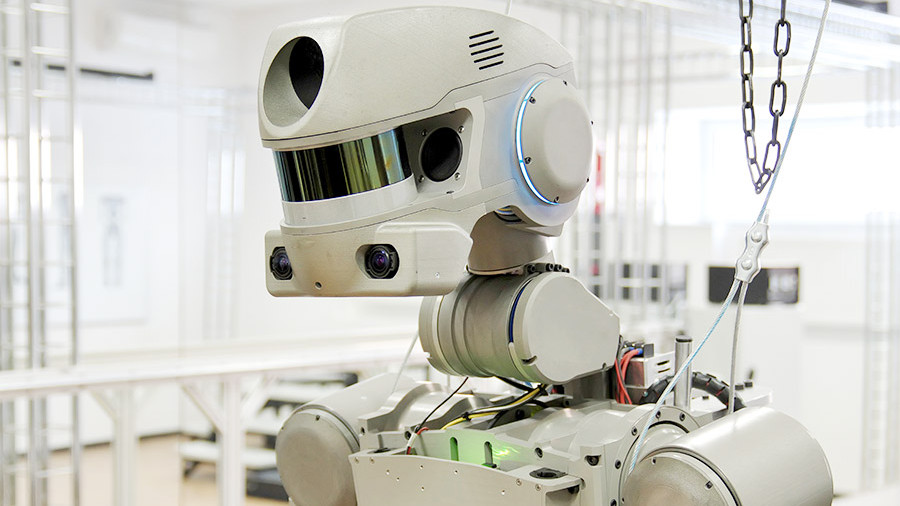Robot "Fedor" will be tested on the spacecraft "Federation"

The leading scientific institute of the rocket and space industry, TsNIIMash, approved the space experiment program “Study of the possibilities of using a remote-controlled anthropomorphic robot in promising manned transport vehicles of the new generation”, the Izvestia newspaper, which often has exclusive information about events in the aerospace industry of Russia, became known .
The space experiment suggests testing under conditions of weightlessness of the space version of the Fyodor robot. This robot (Final Experimental Demonstration Object Research - FEDOR) was created by the Advanced Research Foundation commissioned by the Emergencies Ministry in the framework of the Rescue Project. To the II quarter. 2020 promise to prepare the flight sample of the space version of "Fedor".
The question is whether the Federation ship will be ready by this time, a kind of Russian response to the American Dragon from SpaceX.
Federation spacecraft
The Federation is a reusable manned spacecraft, which should replace the manned spacecraft of the Soyuz series and automatic cargo ships of the Progress series. Currently being developed by the Energia Rocket and Space Corporation.
The total mass of the ship when flying to the orbital station will be equal to 14.4 tons (19 tons when flying to the Moon), the mass of the returned apparatus is 9 tons. The length of the ship is 6.1 meters. The nominal overload during descent is 3 g (information from the Roscosmos website).
According to the Roskosmos technical specification , “a manned transport ship of a new generation should provide an opportunity to fly to a near-moon orbit using inter-orbital transportation means, approach and dock with orbital stations, fly along a near-moon or near-earth orbit in manned and unmanned modes, transfer from near-moon orbit to orbit at orbit. to Earth with the 2nd cosmic velocity and the safe return of the crew to Earth. At the same time, the multiplicity of possible use of the returned apparatus when performing near-Earth flights and flights to the Moon should be at least 10 ".
When implementing lunar manned programs, the Federation ship should ensure an autonomous flight duration with a crew of 4 people for at least 30 days, and as part of the near-moon orbital infrastructure, if there are appropriate life support systems, at least 180 days. When performing flights in near-earth orbit, the ship must provide the ability to accommodate up to 6 crew members and the duration of the flight as part of the orbital infrastructure for at least 365 days.
Unfortunately, because of international sanctions in Russia, it is impossible to use Western software for simulating ship tests, so the Federation will be tested on mock-ups before the first starts.
Earlier, the first launch was planned to be held in 2021 from the Vostochny cosmodrome on the Angara carrier rocket , but in May 2017 sources in the rocket and space industry reported that Roskosmos plans to postpone the launch to 2022 and to launch it from the Baikonur cosmodrome on the new rocket - carrier of the middle class "Phoenix". “Roskosmos proposed to revise plans for the launch of the manned ship“ Federation ”and to transfer the implementation of this project to the Baikonur cosmodrome. The launch of the ship will be carried out on a new carrier rocket of the middle class, developed in the framework of the project “Phoenix”. This project is planned to be implemented within the framework of the Baiterek complex. This will not require serious alterations in the ship, since the created new launch vehicle will use the RD-170M forced engines, and the flight tests of this complex are scheduled for 2022, ”the source told TASS.
In June, Roskosmos confirmed the transfer of the launch site, but the head of the space agency, Igor Komarov, said that the spacecraft would be put into orbit by the Soyuz-5 launch vehicle.
The previous project of the Federal Space Program, before the budget cuts, assumed the financing of this project in the amount of 66.689 billion rubles. Then funding was reduced to 58 billion rubles . This is 3.5 times less than the cost of creating a Dragon spacecraft from SpaceX.
Almost 30 billion rubles have been allocated for the creation of the Phoenix rocket.
Flight Model "Fedor"
It is reported that on board the "Federation" robot will only simulate the functions of the pilot. The unmanned ship itself will receive commands from Earth. The experiment will only check whether Fedor is capable of functioning in zero gravity conditions and how it can be used. During the day of the flight they will hold three communication sessions of 30-45 minutes, when the operator controls the robot.
“When creating Fedor, we were guided by the need to replace people on remote-controlled and autonomous anthropomorphic robots when working in space, the deep sea and in other conditions with factors dangerous to life and health,” Sergei Hurs, a project manager at FPI, told Izvestia. He also believes that such robots can be used for long work in open space.
The terms of reference for the experiment has been agreed and the technical assignment for scientific equipment is being developed.
A few days ago, Roskosmos officially announced the beginning of the development of a new on-board radio telemetry system (BRTS), which will fully ensure the connection of the Federation ship with the Earth, collecting information from all its service systems: control, telemetry, television system and the Fedor robot.
According to the plan of Roscosmos, “Fedor” will become the first and only member of the crew of the new ship during test flights.
All Articles